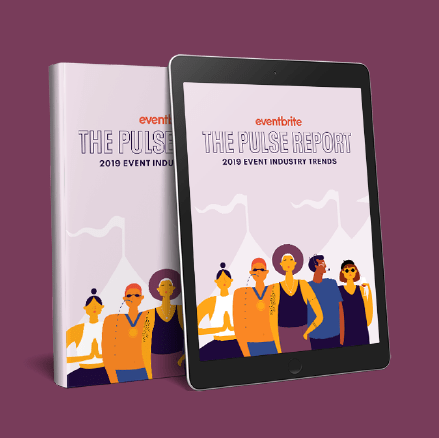It’s time to build your nonprofit’s fundraising plan for 2019. You know what you did last year and your goals for the year to come. But in your rush to create an airtight fundraising plan, it can be very easy to overlook a critical factor: what other nonprofit events are doing.
If you don’t know what other Australian nonprofit events have planned for 2019, you’ll be stuck in your own status quo. Stand out to donors by learning what the local nonprofit industry is investing in — so you can innovate to hit your aggressive fundraising goals.
As part of the 2019 Eventbrite Pulse Report, we surveyed over 600 event creators in Australia and New Zealand, including 136 nonprofits, about how they use events to fundraise. Here are the trends and benchmarks you need to know to shape your own fundraising efforts.
About the respondents: Most respondents work at smaller nonprofits (55% 2-24 employees, 18% 25-250 employees, 12% 250-999 employees). 37% host 2-5 events per year, and 14% host more than 25 events per year.
The most common types of events nonprofits are organising
The great majority — 78% — of nonprofits in Australia most frequently host cause, community, and educational events. Not surprisingly, 22% of them also host galas and fundraisers. But a significant portion of nonprofits also throw:
- Networking events (45%)
- Training and workshops (39%)
- Consumer education/classes (30%)
- Food and drink events (27%)
- Arts and entertainment events (17%)
This variety of formats makes sense when you break down why nonprofits create events in the first place. In addition to raising funds and motivating donations, nonprofits host events to:
- Raise awareness for their cause (40%)
- Build community (65%)
- Offer training or education (64%)
If your primary goal is community awareness, but your events are all exclusive galas, you may be missing an opportunity to connect with donors in a new way.
Pro tip: Whatever type of event your nonprofit hosts, make sure it’s a success. For more information read : Event Planning for Nonprofits.
Top revenue sources for nonprofit events
Revenue is critical to call any nonprofit event a success. Here are nonprofit events’ largest revenue drivers:
- 64% ticket sales
- 39% sponsorships
- 56% grants or donations
Yes, ticket sales are a main source of revenue for nonprofits. But exactly how much of their revenue comes from ticket sales varies wildly:
- 15% say it’s between 80-100%
- But for a quarter, it’s less than 20%
The takeaway: If you’re like many other nonprofits, you have to diversify your revenue to meet your goals.
Pro tip: Use this list of fundraising ideas to think bigger about your fundraising goals.
How nonprofits spend their events budgets
Keeping costs in line is vital to have the most funds left for your cause at the end of a fundraising event. But some expenses are unavoidable. Here are nonprofit events’ top line items:
- Food and beverage expenses (57%)
- Facility rental (47%)
- Programming costs (32%)
- Staffing (34%)
This year, 62% of nonprofit event creators expect their budget to hover around the same figure. But across the board, they expect those big expenses to increase.
How nonprofits select a venue for their fundraising events
With facility rental such a huge line item, how do nonprofits go about selecting venues? Here are the factors they consider “very important”:
- Cost (86%)
- Location (86%)
- Flexibility of space (65%)
- Capacity (65%)
- Accessibility (64%)
Other factors include customer service staff, parking, sustainability, and available public transportation. But fewer nonprofit event creators prioritise these factors.
You, on the other hand, just might. For example, if your nonprofit has an environmental cause, a sustainable venue might be very important to you. Or if your audience is going to be commuting from far-flung neighbourhoods, public transportation might be very important.
Pro tip: Regardless of your priorities in choosing a venue, read 8 Questions You Must Ask An Event Venue Before Signing.
The most effective marketing tactics for nonprofit events
Nonprofit event creators say that their most effective marketing tactics are:
- Social media marketing (29%)
- Email (28%)
- Word of mouth/referrals (23%)
On social media specifically, nonprofit events rely on organic posts (64%), paid Facebook or Instagram posts (15%), and display ads (5%).
Of course, not every marketing tactic can be a slam dunk. Less effective marketing techniques include guerrilla marketing, third-party listings, search engine optimisation (SEO), webinars, and Snapchat Geofilters.
The takeaway? You might want to rethink spending money on Snapchat if it’s not a channel that is highly effective for your events. Instead, tap into your network to take advantage of word of mouth and referrals, or work on building your email database.
Pro tip: Read this new data on how event marketing will change in 2019.
Top challenges facing nonprofit event professionals in 2019
Looking ahead in 2019, the biggest challenges for nonprofit event creators include:
- Reaching new attendees (63%)
- Securing sponsors (42%)
- Insufficient budget (55%)
Getting a gauge for what other events are doing will help you tackle all these challenges with finesse this year. Get more insights into the Australian events industry at large in the full 2019 Pulse Report.






